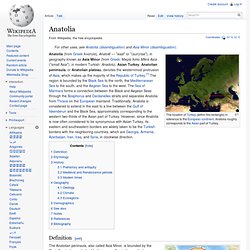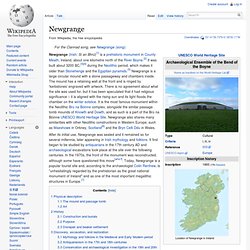

Çatalhöyük. Çatalhöyük (Turkish pronunciation: [tʃaˈtaɫhøjyc]; also Çatal Höyük and Çatal Hüyük; çatal is Turkish for "fork", höyük for "mound") was a very large Neolithic and Chalcolithic proto-city settlement in southern Anatolia, which existed from approximately 7500 BC to 5700 BC, and flourished around 7000BC.[1] It is the largest and best-preserved Neolithic site found to date.

In July 2012, it was inscribed as a UNESCO World Heritage Site.[2] Çatalhöyük is located overlooking the Konya Plain, southeast of the present-day city of Konya (ancient Iconium) in Turkey, approximately 140 km (87 mi) from the twin-coned volcano of Mount Hasan. The eastern settlement forms a mound which would have risen about 20 m (66 ft) above the plain at the time of the latest Neolithic occupation. Anatolia. Coordinates: Definition[edit] The traditional definition of Anatolia within modern Turkey[2][3]

Newgrange. Newgrange (Irish: Sí an Bhrú)[1] is a prehistoric monument in County Meath, Ireland, about one kilometre north of the River Boyne.[2] It was built about 3200 BC,[3][4] during the Neolithic period, which makes it older than Stonehenge and the Egyptian pyramids.[5] Newgrange is a large circular mound with a stone passageway and chambers inside.

The mound has a retaining wall at the front and is ringed by 'kerbstones' engraved with artwork. There is no agreement about what the site was used for, but it has been speculated that it had religious significance – it is aligned with the rising sun and its light floods the chamber on the winter solstice.